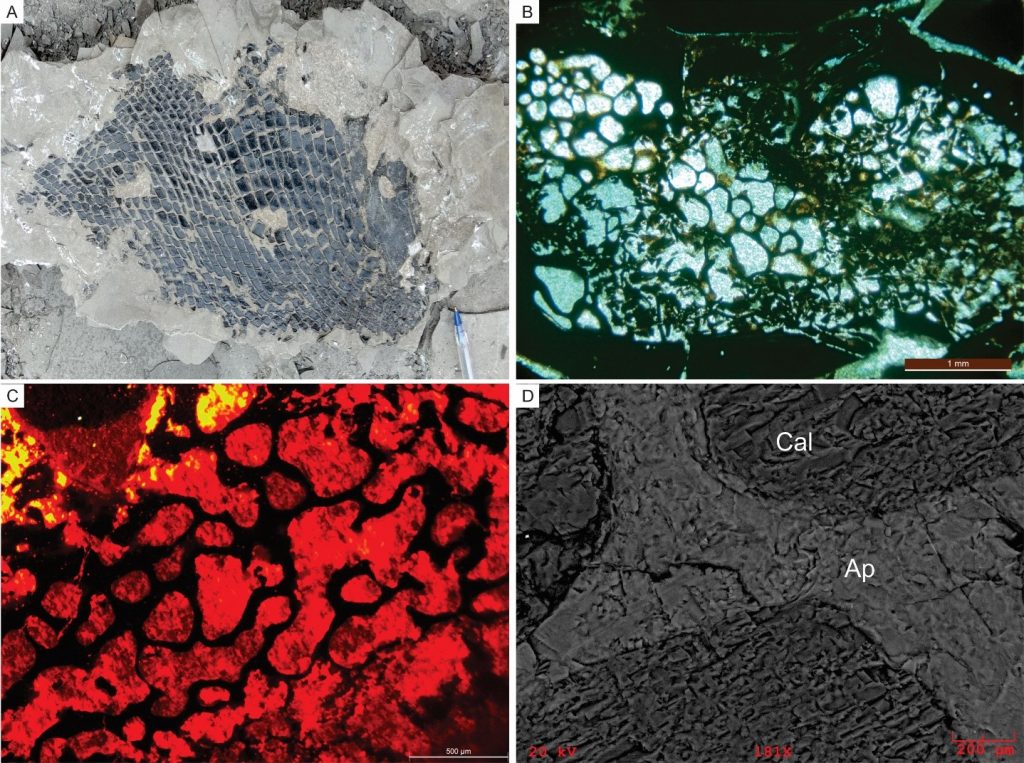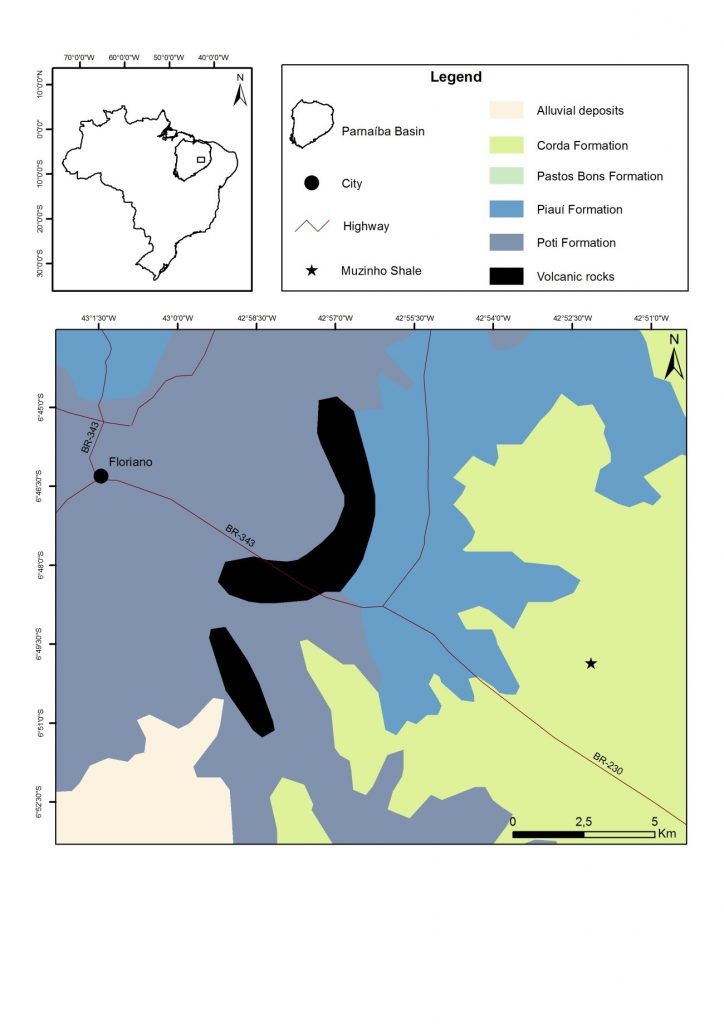05 – INSIGHTS IN THE PRESERVATION OF FISH FOSSILS FROM THE MUZINHO SHALE, LATE JURASSIC- EARLY CRETACEOUS OF THE PARNAÍBA BASIN
Ano 05 (2018) - Número 03 Artigos
![]() 10.31419/ISSN.2594-942X.v52018i3a5ARC
10.31419/ISSN.2594-942X.v52018i3a5ARC
Alexandre Ribeiro Cardoso¹; Guilherme Raffaeli Romero¹; Gabriel Ladeira Osés²; Cleber Eduardo Neri Rabelo¹; Afonso César Rodrigues Nogueira¹
¹Grupo de Análise de Bacias Sedimentares da Amazônia (GSED), Programa de Pós-Graduação em Geologia e Geoquímica, Instituto de Geociências, Universidade Federal do Pará, Belém-PA, Brazil
²Programa de Pós-Graduação da Universidade Federal De São Carlos
alexandre_ribeiroc@hotmail.com; graffaeli@gmail.com; gabriel.ladeiraoses@gmail.com; cleber.rabelo@bol.com.br; anogueira@ufpa.br
ABSTRACT
The Muzinho Shale, lower succession of the Pastos Bons Formation, composes the main Mesozoic fossiliferous beds of the Parnaíba Basin, northeastern Brazil. These beds are composed by millimeter-scale interlayering of limestones and black shales, which include exceptionally well-preserved fish fossils. Although taxonomic studies are well-develop, the taphonomic history of the fossil assemblage is poorly understood. In this sense, we applied petrography, hot cathodoluminescence, x-ray diffraction and SEM/EDS. The petrographic and mineralogical data suggest that the thanatocoenosis passed by a mass mortality event caused by the establishment of anoxic conditions in the lake. High preservation grade indicates that the Muzinho Shale may be characterized as a Konservat-Lagerstätten.
Keywords: Taphonomy; Konservat-Lagerstätten; fish fossils; black shales.
INTRODUCTION
Exceptional fossil preservation is defined by the presence of “articulation of segmented fossil impressions, compressions, nodule-encased fossils, as well as cellular permineralization of plants and soft-part preservation” (Retallack, 2011, p. 60). Such special occurrences, known as Konservat-Lagerstätten, are rare in geological record and may be considered natural laboratories to precisely assess past environments and ecological conditions (Muscente et al, 2017). In the Parnaíba Basin, northeastern Brazil, the succession known as Muzinho Shale, basal portion of the Pastos Bons Formation, is an unprecedented example of a possible Konservat-Lagerstätten in this basin (Fig. 1). These deposits are composed by millimeter to centimeter interbedding of black shales and limestones, with a restricted fossiliferous level, dated as Upper Jurassic-Lower Cretaceous. This is a remarkable record in the Parnaíba Basin, and despite taxonomic studies, the fossil assemblage still lacks properly stratigraphic positioning and taphonomic studies. In this sense, this work aims to unravel the processes and environmental conditions that allowed the exceptional preservation of the fish fossils, such that we addressed petrography, cathodoluminescence, MEV-EDS and X-ray diffraction.
GEOLOGICAL SETTING
The Parnaíba Basin is a Paleozoic intracratonic basin, situated in northeastern Brazil (Góes and Feijó, 1994). This basin is defined as sag-type, comprising approximately 600.000 km² and 3400 to 3500 m-deep in its depocenter (Vaz et al, 2007). The Pastos Bons Formation, focus of this research, consists of reddish to greenish mudstones interbedded sandstones with cross-stratifications or cross-laminations. The basal portion of this unit is constituted by the Muzinho Shale, the main Mesozoic fossiliferous beds in the Parnaíba Basin (Gallo, 2005). The Muzinho Shale consist in black shales with a rich fossil content, mainly represented by complete specimens of Lepidotes piauhyensis, Semionotus, Pholidophoridae, Macrolimnadiopsis and Macrosemiídeos, which indicates a Late Jurassic-Early Cretaceous age (Gallo, 2005). These beds occur interlayered with limestones and are sharply covered by sandstone packages.
MATERIALS AND METHODS
Taphonomic aspects were analyzed in the Muzinho Shale outcrop. Twelve thin-sections of the fish fossils and host rocks from the Muzinho Shale were evaluated, focusing on original features and diagenetic modifications. Samples were imaged by hot cathodoluminescence analyses, carried out in a CITL Cathodoluminescence Mk5-2. The system was operated with an acceleration voltage of 15 Kv and 150 µA current, vacuum between 0.003 and 0.05 Pa, exposure time of 10 to 15 s. X-ray diffraction followed the total-rock method and was performed with an X’Pert MPD-PRO PANalytical diffractometer, equipped with Cu anode (λ=1,5406) aiming to characterize the black shales. Analyses with scanning electron microscopy (SEM) were performed in a SEM model LEO-1430. All analyses were performed in the Instituto de Geociências – Universidade Federal do Pará, in order to obtain details of the fish structures.
RESULTS AND DISCUSSIONS
The Muzinho Shale includes the only abundant fossiliferous beds known for the 80 m-thick Pastos Bons Formation. Fish fossils are complete, without burrowing and enclosed by crenulated to convolute laminations succeeded by limestone laminae (Fig. 2A). These laminations are organic matter rich and composed by Fe-smectites, as identified by EDS analyses, which occur as continuous to discontinuous levels. Fe-smectites also fill interstices between scales and throughout random microfractures over the scales. The ichthyofauna presents polytypical assemblage, with variable sizes (up to 30 cm), and young to adult individuals in the same horizon. These fossils exhibit smooth ganoid scales with 4-6 mm-length, which decrease in thickness towards the extremities of the fossils. These structures are rectangular in the dorsal region and grades to rhombohedral in the caudal portions and close to the cranium (Fig. 2A). The pectoral, pelvic, dorsal, anal and caudal fins are well-preserved, present elongate geometry and are ornamented by segmented and ramified concentric rays, densely and asymmetrically spaced (≥12 rays) (Gallo, 2005). Fine-grained and euhedral barite and chalcopyrite crystals occur disseminated between these rays. Microscopically, muscle and, possibly, connective tissues are well-preserved. The former are organized as irregular myomeres of 5 to 60 µm with predominantly rounded and ellipsoidal morphologies, commonly filled by calcite poikilotopic crystals (Fig. 2 B, C). Myomeres may be complete or fragmented, with superposition or complex deformation of the inner structures (Fig. 2B). The boundaries of these structures are muscular inner walls of 1 to 20 µm, although restrict connections occur locally. These are constituted by francolite and fluorapatite, with local occurrence of fine-grained disseminated pyrite and/or chalcopyrite (Fig. 2D).
Taphonomy
The ichthyofauna of the Muzinho Shale present features that allow classifying it as exceptionally well-preserved, such as the occurrence of soft tissues and skeletal structures (Retallack, 2011). These characteristics may indicate that these beds compose a Konservat-Lagerstätten in the Parnaíba Basin. The occurrence of polytypical individuals with diverse development stages and the high concentration of the thanatocoenosis in a specific horizon may indicate mass mortality (Petra, 2006). This event was probably caused by anoxic conditions, as indicated by fossils with tetany, gasping features and columnar curvature (Gallo, 2005). Anoxic diagenetic conditions are indicated by pyrite, chalcopyrite and baryte crystals. The lake bed anoxia was probably influenced by water column deepening and consequently lake water stratification. The unselective mass mortality may have been provoked by termocline demise due to oxygen replenishment in the lake water. In this sense, the fish fossils preservation was mainly enhanced by anoxic conditions and probably bacterial sealing. The later hypothesis is indicated by submillimeter-scale crenulated laminations that enclose the fossils. Further investigations will be performed to understand the origin and role of these structures in exceptional preservation.

Figure 2 – Taphonomic features of fish fossils of the Muzinho Shale. A. Lepidotes piauhyensis specimen (Scale: 5 cm). B. Undeformed and deformed myomeres, filled by poikilotopic calcite crystals in C.. D. Inner walls, composed by apatite and/or francolite (Ap). Calcite (Cal) occurs filling the primary voids.
CONCLUSIONS
The thanatocenosis of the Muzinho Shale was probably accumulated in anoxic mass mortality events. Anoxic bottom water and sulphate-reducing bacterial sealing probably allowed exceptional preservation features of the fish fossils. Characteristics as soft parts conservation, including the inner structures of the fish fossils, indicate the possible occurrence of the first Konservat-Lagerstätten in the Parnaíba Basin. The Muzinho Shale is the only abundant fossiliferous occurrence known of the Pastos Bons Formation. Further analyses will be performed to understand this distribution and to recognize environmental variations in the paleolake.
Acknowledgments
We are very grateful to the Laboratório de Difração de Raios-X of the Instituto de Geociências – UFPA, Hudson Santos for cathodoluminescence analysis, Gisele Tavares for MEV/EDS data and Joelma Lobo for thin sections. We also thank the editorial body for helpful suggestions.
REFERENCES
Gallo V., 2005. Redescription of Lepidotes Piauhyensis Roxo and Löefgren, 1936 (Neopterygil, Seminotiformes, Semionotidae) from the ?Late Jurassic-Early Creataceous of Brazil. Journal of Vertebrate Paleontology, 25(4): 757-769.
Góes A.M.O., Feijó F.J. 1994. A Bacia do Parnaíba. Boletim de Geociências da Petrobras, p. 57-67.
Muscente A. D., Schiffbauer, J. D., Broce J.; Laflamme M., O’donnel K., Boag T. H., Meyer M., Hawkins A. D., Huntley J. W., Mcnamara M., Mackenzie L. A., Stanley Jr. G. D., Hinman N. W., Hofmann M. H., Xiao S. 2017. Exceptionally preserved fossil assemblages through geologic time and space. Gondwana Research, 48:164-188.
Petra M.S. 2006. Paleoictiofauna da Formação Pastos Bons (Bacia do Parnaíba) – Reconstituição Paleoambiental e Posicionamento Cronoestratigráfico. MS Dissertation. Universidade do Estado do Rio de Janeiro, Rio de Janeiro, 141 p.
Retallack G. J., 2011. Exceptional fossil preservation during CO2 greenhouse crisis? Palaeogeography, Palaeoclimatology, Palaeoecology, 307: 59-74.
Vaz, P.T.; Rezende, N.G.A.M.; Wanderley Filho, J.R.; Travassos, W.A.S., 2007. Bacia do Parnaíba. Boletim de Geociências da Petrobras, 15 (2): 253-263.

